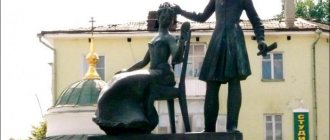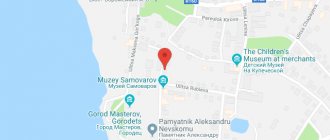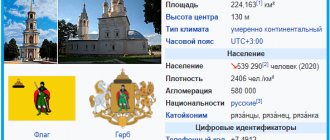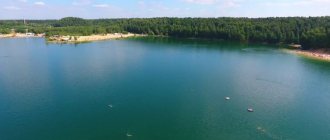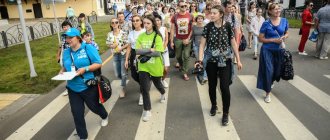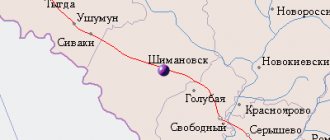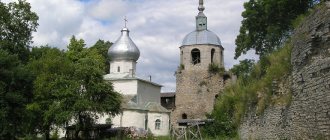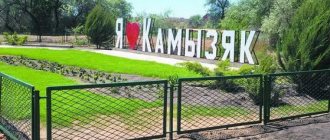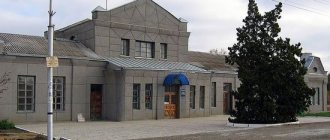This term has other meanings, see Gorodets (meanings).
Coat of arms
| City | |
| Gorodets | |
| City of masters | |
]
Moscow
Nizhny Novgorod
Gorodets
Media files on Wikimedia CommonsGorodets
- a city (since 1171) in the Nizhny Novgorod region of Russia.
The administrative center of the Gorodets district, which includes an administrative-territorial entity (city of district significance)[4] and the municipal entity of the same name, the city of Gorodets
with the status of an urban settlement as its only populated area[5].
History[ | ]
Gorodets in the Middle Ages[ | ]
Gorodets is one of the oldest Russian cities in the Middle Volga; it arose in the second half of the 12th century as a fortress to protect the borders of Vladimir Rus' from the campaigns of the Volga Bulgars.
In popular and local history literature, there is a widespread point of view about the founding of Gorodets in 1152 by Yuri Dolgoruky[6], which was also accepted by a number of official publications[7]. However, most scientists attribute the founding of the city to the reign of Andrei Bogolyubsky. The history of Gorodets dates back to 1171[8], when it was mentioned in the Laurentian Chronicle in connection with the campaign of Prince Mstislav Andreevich against Volga Bulgaria. Data from archaeological excavations[9] also allow us to attribute the emergence of the city to the second half of the 12th century.
In February 1238, the city was burned by Batu’s troops, but quickly recovered and between 1263 and 1282 it was the capital of the Gorodets principality[10]. On November 14 (old style), 1263, on the way from the Golden Horde to Gorodets, the great Vladimir prince Alexander Yaroslavich Nevsky died. According to church tradition, on the eve of his death he took monastic vows in the Fedorovsky Monastery with the name of Schemamonk Alexy.
After the death of Alexander Nevsky, his third son Andrei Alexandrovich received the Gorodets principality as an inheritance and ruled it until his death. Prince Andrey is the initiator of brutal civil strife in Vladimir-Suzdal Rus' in the 1280-1290s. For the last ten years of his life he occupied the throne in Vladimir. He died on July 27, 1304, and was buried in the Church of Michael the Archangel of Gorodets (not preserved).
In the 2nd half of the 14th century, it was part of the Suzdal-Nizhny Novgorod Grand Duchy (founded in 1341), and was the center of an appanage reign. A significant role in the political life of the region at that time was played by the Gorodets prince Boris Konstantinovich from the dynasty of the Suzdal-Nizhny Novgorod great princes. Gorodets is known as the birthplace of the famous icon painter Elder Prokhor of Gorodets, the mentor of Andrei Rublev.
In December 1408, it was burned by Edigei, after which it disappeared from the political map of Rus', for a long time being called Empty Gorodets.
Around 1469, Afanasy Nikitin visited the city.[11]
In 1565, after Tsar Ivan the Terrible divided the Russian state into oprichnina and zemshchina, the city became part of the latter[12][13].
Gorodets in modern times[ | ]
Residential building decorated with wood carvings (Gorodets, 2015) Nizhny Novgorod province.
Gorodets, view from the Volga. 1900s Until 1700, the Volga changed its course and moved away from the center of Gorodets[14]. It emerged again as a craft village at the end of the 16th and beginning of the 17th centuries. Gorodets was a volost village in Yuryevetsky, then in Balakhninsky district[15].
Since the end of the 18th century, it has been known as a center for wooden shipbuilding, grain trade, baking printed gingerbread, and as a sales point for handicrafts made of wood - the so-called “chip goods” (wooden utensils, spinning wheels, etc.). According to contemporaries, in winter the Saturday market in Gorodets was not inferior to many fairs, covering with its influence several nearby districts of the Nizhny Novgorod, Vladimir and Kostroma provinces.
The second half of the 19th and beginning of the 20th centuries was the heyday of Gorodets. Remaining a volost village, Gorodets acquired the features of a wealthy merchant city. There were two iron foundries and mechanical plants, shipyards for the construction of barges in Zaton and Nizhnyaya Sloboda, a steam mill, tanneries and timber factories, and gingerbread establishments. With the money of merchant-philanthropists in Gorodets, an orphanage, public schools, men's and women's gymnasiums, an all-class club (with a theater auditorium and a library), a volunteer fire brigade, a temperance society and much more were established.
At this time, Gorodets was a large trading center (in 1890, 2,258 thousand poods of goods arrived there along the Volga, 525 thousand poods were sent), and the main item of trade was bread. In the village there were three Orthodox churches, as well as an Old Believer chapel (Gorodets was one of the main centers of the Old Believers of the priestly persuasion)[15].
Recent history of Gorodets[ | ]
Map of Gorodets and its environs in 1929
In 1921, the center of the Balakhninsky district was moved to Gorodets, and the district was renamed Gorodetsky. In 1922 it received the status of a county town, but socialist transformations broke its previous economic structure. The first Soviet five-year plans did not significantly change the appearance of Gorodets. Due to the lack of sites for large industrial enterprises and railway connections with Gorky, the socio-economic life of the city developed slowly.
In the post-war period (1950-1960s), the city received an impetus for development. The shipyard, ship repair and mechanical plant were completely reconstructed, a shoe factory, a stitching embroidery factory and the Gorodets Painting factory were built. The Spartak stadium, then one of the best in the region, became the decoration of the city. During these years, mass housing construction began, which continued later (shipyard village, mechanical plant village, Furmanovsky, Severny microdistricts, etc.).
In the 1960s-1980s, in the area of Proletarskaya Square, the administrative center of the city was practically re-formed (administration, social and cultural institutions, school, kindergarten, city park, department stores, bus station, etc.) In the area of the village of Matryonino, in the continuation of Novaya and On the highway "Gorodets - Nizhny Novgorod" the residential microdistrict Melioratorov was founded. The city will probably grow in this direction in the future.
The impetus for the revival of Gorodets as a small historical town and a center of folk crafts was the annual City Day. It has been held since 1984 on the first weekend of September (first on the second Sunday, then on the second Saturday of the month).
Recently, inbound tourism and museums have received active development in Gorodets. This was greatly facilitated by the regional festivals “Gorodets - the Museum Capital” (since 2003) and “Masters of Folk Brotherhood” (since 2002 on the third Saturday of July).
Since 2006, the city has successfully implemented a regional program for the development of culture and tourism called “Gorodets - 21st century”. During the program, the central part of the city was improved, new museums were opened, the Feodorovsky Monastery was restored, and the museum and tourist complex “City of Masters” was built (both in 2009).
Formation of Gorodets
A new stage in the history of the city began in the middle of the 14th century. In 1341, the Grand Duchy of Nizhny Novgorod arose, one of whose appanages was Gorodets. Boris Konstantinovich reigned here - an ambitious and energetic politician, an irreconcilable rival of the rising Moscow. However, neither Boris nor his descendants could stop the growth of its power.
Gorodets Photo: nnwelcome.ru
At the turn of the 14th–15th centuries, Gorodets was noticeable not only in the political, but also in the cultural life of Rus'. An outstanding master of icon painting, Elder Prokhor, came from Gorodets. In 1405, together with Theophan the Greek and Andrei Rublev, he participated in the painting of the Annunciation Cathedral in the Moscow Kremlin.
One of the last mentions of Gorodets in chronicles dates back to December 1408. Then Edigei’s army besieged Moscow, ravaged Pereslavl-Zalessky, Rostov, Dmitrov, Klin, Serpukhov, Nizhny Novgorod and “went to Gorodets and took the city, burning the whole thing with fire...”. Gorodets could not recover from this terrible invasion. Despite its former glory, it has lost its status as a city.
Since the 16th century, Gorodets has been a volost village in Yuryevetsky, then Balakhninsky district. The owners of the village over the years were the Tsar’s daughter Ksenia Godunova, Prince Lobanov of Rostov, Grigory and Vladimir Orlov, and in the 19th century part of Gorodets belonged to Count Panin.
The mansion of the merchant Petelin in Gorodets Photo: Olga Lisenkova/commons.wikimedia.org
In 1722, Peter I, traveling to Astrakhan to lay the sea route there, visited Gorodets and the Feodorovsky Monastery. Back in the 17th–18th centuries, Nizhny Novgorod, Balakhna and Gorodets became centers of shipbuilding. Gorodets carpenters were so famous for their art that Peter I called them to build warships in the village of Preobrazhenskoye. The Emperor involved Gorodets shipbuilders in the creation of the Russian fleet, which took part in the campaigns against Azov.
Population[ | ]
| Population | |||||||||
| 1897[16] | 1926 | 1931[16] | 1939 | 1959[17] | 1967[16] | 1970[18] | 1979[19] | 1989[20] | 1992[16] |
| 6300 | ↗11 200 | ↗12 200 | ↗16 100 | ↗27 019 | ↗31 000 | ↗34 229 | ↗35 727 | ↘34 210 | ↗34 400 |
| 1996[16] | 1998[16] | 2000[16] | 2001[16] | 2002[21] | 2003[16] | 2005 | 2006[16] | 2007 | 2008[22] |
| ↘33 800 | →33 800 | ↘33 700 | ↘33 600 | ↘32 442 | ↘32 400 | ↘31 900 | ↘31 700 | ↘31 500 | ↘31 379 |
| 2009[22] | 2010[21] | 2011[22] | 2012[23] | 2013[24] | 2014[25] | 2015[26] | 2016[27] | 2017[28] | 2018[29] |
| ↘31 357 | ↘30 658 | ↘30 623 | ↘30 447 | ↗30 570 | ↘30 524 | ↗30 563 | ↘30 530 | ↘30 493 | ↘30 188 |
| 2019[30] | 2020[3] | ||||||||
| ↘29 854 | ↘29 712 | ||||||||
As of January 1, 2022, in terms of population, the city was in 511th place out of 1,116[31]cities of the Russian Federation[32].
Economy and culture[ | ]
Gorodets painting.
Industry[ | ]
Traditional branches of local industry are shipbuilding (shipyard, ship repair plant), woodworking, arts and crafts (Gorodets painting and embroidery factories, an enterprise for baking printed gingerbread), as well as processing of agricultural products (milk, RaiPo, Bakery IP Kruglov V.A. and etc.). The first cruise ship in the history of modern Russia, the Sura, was built in the city[33]. In recent years, the production of automotive components (electrical wiring) has developed. One of the oldest enterprises of the All-Russian Society of the Blind (Avtokomplekt LLC) produces cleaning brushes that are sold throughout Russia and even in some CIS countries.
Education[ | ]
Kindergartens No. 4, 9, 10, 11, 13, 14, 15, 16, 18, 19, 21, 24, 29, 46, 49.
Schools No. 1, 2, 4, 5, 7, 12, 13, Evening comprehensive school No. 1, Gorodets specialized (correctional) boarding school of the 5th type, Gorodets specialized (correctional) boarding school of the 8th type
GAPOU "Gorodetsky Provincial College"
Children's music school, Children's art school
Museums[ | ]
The city of craftsmen
Gorodets is known not only as the oldest city in the Nizhny Novgorod region, a center of folk crafts (wood carving, painting), but also as a museum city. It is the only city in the region that has a Museum Quarter in its historical part. The central place in it is occupied by the local history museum - one of the first regional museums in the Nizhny Novgorod region (along with Vetluzhsky), founded in 1918. Since 1920, it has occupied the mansion of merchant I.P. Oblaev Jr. on the street. Lenina, 11 (formerly Kupecheskaya). The museum's collection includes about 16 thousand items of storage of the main fund. His collection of archaeological antiquities from the 12th to 14th centuries, including a princely helmet from the 13th to 14th centuries decorated with silver and gold, as well as a hanging lead seal of Prince Alexander Nevsky, is of national importance. In April 1991, the All-Russian conference “Gorodets Readings” was held for the first time at the museum, which later became a traditional regional scientific forum with the participation of leading archaeologists, historians, archivists, and specialists in the protection of ancient monuments, and since 2016 the museum has been a co-organizer and venue for the traditional seminar “Archaeology of the Nizhny Novgorod Volga region and adjacent territories”[34][35]. On the basis of the local history museum, the Gorodets Historical and Art Museum Complex was created in 2007, which includes several more museums located next to it and on neighboring ones - Andrei Rublev Street, Revolution Embankment and Aleksandrovskaya Embankment:
- Children's Museum on Kupecheskaya
- Museum "Gorodets Gingerbread": opened on July 26, 2008 in the main house of the former mansion of merchant S. F. Tryapkin, which is a monument of architecture and urban planning of federal significance. The building is located at the very beginning of the museum quarter, at the intersection of Lenin and Kirov streets. The museum tells about the history of gingerbread making and modern gingerbread production. The Gorodets Gingerbread Museum is the second (after a similar museum in Tula) dedicated to the history of the sweet industry.
- Museum "House of Countess Panina"
- Museum "Russian Samovar Tower": opened on September 8, 2007 in the Grishaev estate, which is an architectural monument of the 19th century. The basis of the museum’s collection was the private collection of the head of the Zemsky Assembly of the Gorodetsky municipal district, Nikolai Fedorovich Polyakov. The collection includes more than 400 samovars and is considered [ by whom?
] the largest in Russia. In September 2022, N. F. Polyakov’s samovar collection was donated to the city[36]. - City of masters
- Museum "Gallery of Good"
In 2016, the private museum “Gorodets on the Volga” was opened, the exhibition of which includes a collection of ancient coins, items of clothing and everyday life of officials of the pre-revolutionary era, and a collection of paintings by contemporary artists[37].
Gingerbread[ | ]
Forms of Gorodets printed gingerbreads
Gorodets has long been famous for printed gingerbreads. Contrary to the widespread opinion in local history literature about the local gingerbread business back in the 17th century, documentary evidence of gingerbread making in the village of Gorodets, Balakhninsky district, dates back to the end of the 18th century. Judging by the reviews of contemporaries, the gingerbread industry at that time was already quite large. The earliest known gingerbread boards of Gorodets craftsmen also date back to the last quarter of the 18th century (kept in the collection of the State Historical Museum). The development of the gingerbread business in Gorodets was facilitated by the large trade in bread at the local bazaar, as well as the proximity of the Nizhny Novgorod fair, from where gingerbreads were distributed throughout the Volga region and went to the Urals, Don, and Central Asia. The heyday of Gorodets’ “sweet trade” occurred at the end of the 19th century. At that time, more than 30 varieties of gingerbread were baked here (some weighed up to one and a half pounds), and 15 gingerbread establishments operated. Most of the gingerbread makers were Old Believers. The most famous dynasties of gingerbread masters are the Bakharevs, Belyaevs, Glazunovs, Lemekhovs, Shcherbakovs.
During the years of Soviet power, the gingerbread industry declined sharply. In 1930, the Red Gingerbread Artel was created, which was later transformed into the Gorodets Food Processing Plant. Preserving the traditions of the old masters, the food processing plant baked printed gingerbread “Sterlyadki” weighing 5 kg. The author of the printed board for it was a descendant of the famous dynasty of gingerbread masters - carver Georgy (Egor) Illarionovich Bakharev.
In the 1970s, a new stage in the development of gingerbread business began in Gorodets. This was the great merit of the director of the food processing plant, Nina Petrovna Shishkina. Under her leadership, an original recipe for a printed gingerbread called “Gorodets Souvenir” was created, and new printed boards were ordered from the talented wood carving master Valery Georgievich Zelenin.
Currently, the main producers of printed gingerbread are Anna Grigorievna Voronina’s enterprise “Gorodetsky Gingerbread” [38] (former team of the Gorodets food processing plant) and OJSC “Gorodetsky Confectioner” (also known under the brand “LuVeNa - Love, Faith, Hope”). Printed boards are cut by local craftsmen Valery Zelenin, Sergey Sokolov, Victor Galibin. The largest printed gingerbread in Gorodets is baked annually for the regional festival “Folk Craftsmen Brotherhood”. It weighs 20 kg and is made from a board by the famous Gorodets carver Andrei Kolov, intended for casting a cast-iron panel to decorate the museum quarter. The giant gingerbread consists of four parts, baked separately and held together with sugar icing.
Sports[ | ]
The following sports are actively developing in the city: football, cross-country skiing, combat sports (boxing, karate, kickboxing, sambo), and athletics.
The first sports team in Gorodets appeared in 1912 - it was a team of amateur football players. In winter, team members “stood” on skates, skating on the city skating rink (Ceremonov Swamp) or on the Volga. On February 2, 1914, the town residents undertook a unique speed skating marathon from Gorodets to Nizhny Novgorod and back. The athletes covered a distance of almost 60 km on the ice of the river twice in a day (both times spending 3.5 hours on it).
During the years of Soviet power, sports societies were created in the city, including the most numerous and titled - Spartak. Famous athletes and athletes of the 1930s and 1940s were Viktor Andrianovich Krylov (director of the Spartak stadium), Irina Sergeevna Insarskaya (physical education teacher in city schools, Gorodets record holder in many sports, participant in the 1947 All-Russian Spartakiad in Moscow).
A native of the city, USSR champion in speed skating in the sprint all-around, Tatyana Denisova, now also works as a physical education teacher at school No. 2. A student (since 1974) of Vladimir Aleksandrovich Bayanov, she trained on the seasonally filled ice of the Spartak stadium. Currently a member of the Saiga running club.
The most titled athlete in Gorodets is skier Alexey Kuznetsov, bronze medalist at the Squaw Valley Olympics (California, 1960). He was a member of the ski team of the Timiryazev collective farm in the Gorodetsky district and always played for the Urozhay sports society. After finishing his career, the athletes worked as a coach. In memory of the outstanding athlete, a ski race is held annually in Gorodets.
A well-known student of the Gorodets boxing school is Andrei Gogolev, Honored Master of Sports, three-time champion of Russia (1996, 1997 and 1998), world champion in 2001 (his mentor is I.V. Golubkov, Honored Trainer of Russia).
Sports sections operate at the Gorodets stadium "Spartak", a sports and recreation center on the street. Krupinov, in city schools. The local football team plays in the Nizhny Novgorod region championship.
In January 1997, the Saiga running club was founded in the city. KLB members take part in track and field runs and cross-country skiing. Twice Gorodets marathon runners made multi-day runs from Moscow to Gorodets, dedicated to the 850th anniversary of these cities (in 1997 and 2002, respectively). Every year, members of the Saiga club participate in daily propaganda runs: on the eve of Defender of the Fatherland Day - the Smirkinsky Run in memory of internationalist soldiers (40 km along the Gorodets - Sokolskoye highway), and on May 8 and 9 - the Torch of Peace, a relay race in Kovernino , Semyonov, Linda and back to Gorodets.
Since 2002, the traditional athletics marathon “Maly Kitezh” has been held in the city in the summer. About a hundred runners from different cities of Russia (Nizhny Novgorod, Ivanovo, Kirov, Moscow, Izhevsk, Ryazan and others) will start there.
The oldest and, perhaps, the most popular sports competition in Gorodets is the annual track and field relay race for the prizes of the Gorodets Herald newspaper. It has been held since 1934, with stages of the relay passing through the central streets of the city.
Gorodets
Gorodets was founded by Prince Yuri Dolgoruky, who also went down in history as the founder of Moscow. In 1152 (according to another version, in 1172) the prince issued a decree on the construction of a fortress on the eastern borders of the Rostov-Suzdal principality. The fortress was supposed to protect the principality from invasions of the Volga Bulgars. The new fortress was named Gorodets, that is, “town”, “small city”. The name was not unique, since it had already been given to several other fortresses. That is why, when mentioning the city in the chronicles, chroniclers wrote: “Gorodets-Radilov” or “Gorodets-on-Volga”. In addition, there are other names for this city: Small Kitezh (Kidazh, Kitesh). The Gorodets earthen rampart is considered by historians to be a unique monument of the 12th century. The rampart went around the city and served as an obstacle to possible invaders. Dolgoruky repeatedly launched campaigns against the Bulgars. According to scientists, the prince did this rather to intimidate the enemy, preventing his attempts to attack the city. According to the chronicles, Yuri Dolgoruky himself did not rule Gorodets. In 1155, Dolgoruky moved to Vladimir. The new fortress came under the control of his son Vasily, who became the founder of another fortress, Vasilevo (located on the site of modern Chkalovsk), which also became a small settlement over time. After the death of Vasily Gorodets was given to his nephew, grandson of Yuri Dolgoruky Mstislav.
The Bulgars, from whom Gorodets was supposed to defend the eastern borders of the Rostov-Suzdal principality, repeatedly tried to capture the city. In 1184, they once again attempted to capture, but, having failed to achieve their goal, they destroyed the surrounding settlements. The Mongol-Tatar troops managed to destroy the city. In 1238, Gorodets was completely burned by the soldiers of Batu Khan. However, the city was restored very quickly. Rebuilt, Gorodets became the center of the Gorodets principality. It was in this city that Prince Alexander Nevsky died in 1263. Death found the prince in the Fedorovsky Monastery. In 1993, a monument was erected to Alexander Nevsky, which subsequently became a recognizable symbol of the city. Alexander's son, Andrei, received the Principality of Gorodets as an inheritance. Andrei Alexandrovich ruled his estate until his death in 1304 and went down in history under the name Andrei Gorodetsky.
Until the 14th century, Gorodets remained the center of an appanage principality. Then the city became part of the Nizhny Novgorod principality. At the beginning of the 15th century, Gorodets experienced another invasion of the Mongol-Tatars. In 1408, the city was attacked by the troops of Khan Edigei. The destruction was so great that the city's residents were unable to cope with its consequences. Gorodets fell into disrepair and received the nickname “empty Gorodets”. The city virtually ceased to exist. Some time after the departure of the Mongol-Tatars, not far from the place where Gorodets once was, a small village arose, which was also named Gorodets. Gradually the village grew and became subordinate to Nizhny Novgorod.
In the 17th century, Boris Godunov granted Gorodets to his daughter Ksenia. Xenia remained mistress of the city for twenty years (1602-1622). Under Catherine the Great, Gorodets passed to her favorite Count G. Orlov. Then the city passes to Countess Panina, and from her to Princess Volkonskaya.
In 1722, Peter I arrived in Gorodets. On his way to Astrakhan, the Tsar made a stop in Gorodets. Here he visited the Fedorovsky Monastery, where Alexander Nevsky once died. However, first of all, the tsar was not interested in the monastery in Gorodets, but in the shipbuilding that flourished here, to which Peter I, as you know, paid great attention to. The tsar highly appreciated the work of local specialists and decided that he would certainly visit this city more than once. During his second visit to Gorodets, Peter I founded a shipyard near the village of Chernoye. Here, by decree of the tsar, Volga-type ships were to be built. Peter also considered it necessary to take the best carpenters and shipbuilders to the village of Preobrazhenskoye (now within Moscow) to build the first Russian fleet. The Tsar was preparing for a campaign against Azov. The town residents wanted to build a chapel in memory of Peter the Great's visit to the city. It is known that the local merchant Osokin sent a petition to the Tsar asking for permission to build. The first chapel was wooden. In 1855 it was replaced with stone.
At the turn of the 18th-19th centuries, Gorodets became the center of the Old Believers, or, as it was also called, the center of the Nizhny Novgorod schism. This was due to the fact that the Old Believer martyr Avvakum was from the Nizhny Novgorod province. Avvakum preached in the city of Yuryevets. Residents of Gorodets, who often visited this city “on trade matters,” joined the sermons of Avvakum. At home, they told their relatives about the preacher, sincerely considering him a saint. There were more and more supporters of Avvakum in Gorodets. Members of merchant families most often became Old Believers. After all, it was the merchants who contributed to the penetration of Habakkuk’s teachings into the city.
The merchant class constituted the main population of the city in the 18th-19th centuries. Historians count more than two hundred merchant families. The Old Believers brought positive changes to the life of the city. Thanks to the Old Believers merchants, economic growth began in Gorodets: trade, crafts and shipbuilding were successfully developing.
The 19th century in Russia began with the War of 1812. Many residents of Gorodets took part in the hostilities, becoming militia warriors. In memory of the heroes who did not return from this war, the Church of the Intercession was built. The church was completed in 1824 and assigned to the Fedorovsky Monastery, becoming part of its complex. The Gorodets Local History Museum also dedicated one of its exhibitions to the two-hundred-year-old event, “The Patriotic War of 1812.” The exhibition displays personal belongings of soldiers who took part in the battle.
Like many county towns of the early 20th century, Gorodets took an active part in the revolutionary movement. At the beginning of 1905 (a few weeks after Bloody Sunday), a “branch” of the RSDLP appeared in the city. The organization consisted of about twenty people. In November 1917, a Council was organized in Gorodets, which was headed exclusively by anarchists and Socialist Revolutionaries. There were no deputies from workers and peasants there. The Council of Peasants and Proletarians appeared only in 1918.
The end of the 30s and the beginning of the 40s became years of trials for the residents of Gorodets, the first of which was the war with the White Finns. And in June 1941, the Great Patriotic War began. The entire male population of the city capable of carrying weapons went to the front. The women who remained in the rear took the places of their husbands, brothers and sons at the machines in the factories. All enterprises in the city were engaged in the production of cartridges. The greatest contribution to the common cause was made by the city shipyard, which collected 70 thousand rubles for the front, a rather impressive amount in those years. In addition to the production of cartridges, the residents of the city had other important tasks: caring for wounded soldiers and caring for evacuees. Today, numerous memorial plaques and monuments remind us of the military glory of the city in Gorodets, for example, the monument to the unknown soldier, installed on the street named after Alexander Nevsky.
The modern stage in the history of the city begins in the early 20s of the last century, when Gorodets received the status of a city. Residents of today's Gorodets continue to develop the industry that appeared in the city thanks to their ancestors - shipbuilding. The folk crafts that made the city famous throughout the country are also not forgotten. Gorodets gingerbread is one of these folk crafts. Gingerbread disappeared from the lives of city residents for many years, giving way to “serious” industry. However, quite recently it was decided to start producing this Gorodets delicacy. The main producer of gingerbread in the city is OJSC Gorodetsky Confectioner.
Religion[ | ]
Historically, Gorodets was the center of the Old Believers in the Russian Empire. Here representatives of Orthodoxy lived peacefully next to Old Believers of various accords (directions).
During the years of Soviet power, churches of all faiths in the city of Gorodets were closed, and some of them were completely destroyed. In the 1990s, the restoration of churches began. Nowadays in the city there are Orthodox churches of the Archangel Michael (1712), Spassky (1752), Intercession (1824)[39], the Old Believer (Old Orthodox) Church of the Assumption of the Virgin Mary, the Edinoverie Church of the Exaltation of the Cross is being restored[40]. In 2009, Patriarch Kirill of Moscow and All Rus' consecrated the restored Gorodetsky Monastery of Feodorovsky.
On the territory of the former Detinets there is a temple in the name of the Dormition of the Blessed Virgin Mary - a small brick church built after 1905 - a low, single-domed quadrangle with a hipped bell tower. Initially, this church belonged to the Old Believers, who accepted the Belokrinitsky hierarchy. Closed in the 1930s. In the 1990s, it was returned to the Old Believers of the Novozybkov hierarchy under the jurisdiction of Patriarch of Moscow and All Rus' Alexander (Kalinin), as the largest Old Believers community in the city, and repaired.
In 2012, Gorodets became the center of the Gorodets and Vetluzh diocese of the Russian Orthodox Church of the Moscow Patriarchate, which included parishes in the northern regions of the Nizhny Novgorod region. The head of the diocese is Bishop Augustine (Anisimov), former rector of the Feodorovsky Monastery.
In addition, representatives of other Christian denominations live in the city, including, since the mid-19th century, representatives of the Roman Catholic and Lutheran churches, who do not have their own religious buildings. Since the middle of the 20th century, a community of Evangelical Christian Baptists has been active in the city, and since the end of the 20th century - Jehovah's Witnesses.
Gorodets merchant
The heyday of Gorodets came in the second half of the 19th century and the beginning of the 20th century - during the era of rapid development of Russian capitalism. Gorodets quickly became rich in shipping, shipbuilding, and trade. Thanks to wintering in the local backwater of ships loaded with grain, the flour-grinding industry and grain trade flourished in the city. At the same time, Gorodets became a major center for the sale of handicrafts. In the surrounding villages they made pottery, horse bows, sleighs, and children's toys. Here, in the 1870s, narrative painting on spinning wheels appeared - the famous Gorodets painting.
By the end of the 19th century, Gorodets had changed. In the mountainous part, rich houses stood on the Volga embankment and Kupecheskaya Street (now Lenin). Below, under the Trinity Cathedral, Bolshaya Street stretches along the river with shopping arcades, shops and shops.
After the October Revolution, in 1933 Gorodets received the status of a district town. However, socialist transformations broke the economic structure, and “Merchant Town” became a thing of the past.
Eight and a half centuries is an honorable age. But Gorodets is an ancient and young city at the same time. Having visited it once, you will definitely love it and return here more than once.
Notes[ | ]
- Chairman of the Gorodets City Duma
- Nizhny Novgorod Region. Total land area of the municipality
- ↑ 12
Population of the Russian Federation by municipalities as of January 1, 2022 (Russian). Date accessed: October 17, 2022. Archived October 17, 2022. - Register of administrative-territorial entities, urban and rural settlements of the Nizhny Novgorod region dated January 15, 2019
- Law of the Nizhny Novgorod Region of June 15, 2004 No. 60-Z “On granting municipalities - cities, workers' settlements and village councils of the Nizhny Novgorod Region the status of urban and rural settlements"
- Bakhareva N.N.
Gorodetsky Theodore Icon of the Mother of God Monastery // Orthodox Encyclopedia. - M., 2006. - T. XII: “Gomel and Zhlobin diocese - Gregory Pakurian.” — 752 p. — 39,000 copies. — ISBN 5-89572-017-X. - THE USSR. Administrative-territorial division of the union republics on January 1, 1980 / Comp. V. A. Dudarev, N. A. Evseeva. - M.: Izvestia, 1980. - 702 p. — P. 118.
- Pudalov B. M.
The initial period of the history of Gorodets in the context of chronicle news // Gorodets readings.
Gorodets, April 25, 2002 (unspecified)
.
Volzhsky Crossroads
(November 29, 2007). - Guseva T.V.
Results and prospects of the archaeological study of Gorodets on the Volga // Gorodets readings.
Gorodets, April 24–26, 1991 (unspecified)
.
Volzhsky Crossroads
(November 17, 2007). - Pudalov B. M.
Part 2. The Gorodets principality in the last third of the XIII - first third of the XIV centuries // The initial period of the history of the most ancient Russian cities of the Middle Volga region (XII - first third of the XIII century).
- N. Novgorod, 2003. Archived copy (unspecified)
(inaccessible link). Retrieved March 22, 2007. Archived September 27, 2007. - Walking across three seas by Afanasy Nikitin. - L., 1986. - P. 57.
- Storozhev V.N.
Zemshchina // Encyclopedic Dictionary of Brockhaus and Efron: in 86 volumes (82 volumes and 4 additional). - St. Petersburg, 1890-1907. - Zemshchina // Great Russian Encyclopedia: [in 35 volumes] / ch. ed. Yu. S. Osipov. — M.: Great Russian Encyclopedia, 2004—2017.
- Bulgakov CB
Feodorovsky Gorodetsky // Chronos. - M.. - ↑ 12
Gorodets, village of Nizhny Novgorod province // Encyclopedic Dictionary of Brockhaus and Efron: in 86 volumes (82 volumes and 4 additional). - St. Petersburg, 1890-1907. - ↑ 12345678910
People's encyclopedia "My City". Gorodets - All-Union Population Census of 1959. The size of the urban population of the RSFSR, its territorial units, urban settlements and urban areas by gender (Russian). Demoscope Weekly. Access date: September 25, 2013. Archived April 28, 2013.
- All-Union Population Census of 1970 The size of the urban population of the RSFSR, its territorial units, urban settlements and urban areas by gender. (Russian). Demoscope Weekly. Access date: September 25, 2013. Archived April 28, 2013.
- All-Union Population Census of 1979 The size of the urban population of the RSFSR, its territorial units, urban settlements and urban areas by gender. (Russian). Demoscope Weekly. Access date: September 25, 2013. Archived April 28, 2013.
- All-Union population census of 1989. Urban population (undefined)
. Archived from the original on August 22, 2011. - ↑ 1 2
All-Russian population census 2010.
Number and distribution of the population of the Nizhny Novgorod region (unspecified)
. Retrieved July 30, 2014. Archived July 30, 2014. - ↑ 123
Nizhny Novgorod Region. Estimated resident population as of January 1, 2008-2016 - Population of the Russian Federation by municipalities. Table 35. Estimated resident population as of January 1, 2012 (unspecified)
. Retrieved May 31, 2014. Archived May 31, 2014. - Population of the Russian Federation by municipalities as of January 1, 2013. - M.: Federal State Statistics Service Rosstat, 2013. - 528 p. (Table 33. Population of urban districts, municipal districts, urban and rural settlements, urban settlements, rural settlements) (undefined)
. Retrieved November 16, 2013. Archived November 16, 2013. - Table 33. Population of the Russian Federation by municipalities as of January 1, 2014 (unspecified)
. Access date: August 2, 2014. Archived August 2, 2014. - Population of the Russian Federation by municipalities as of January 1, 2015 (unspecified)
. Access date: August 6, 2015. Archived August 6, 2015. - Population of the Russian Federation by municipalities as of January 1, 2016 (Russian) (October 5, 2018). Retrieved May 15, 2022. Archived May 8, 2022.
- Population of the Russian Federation by municipalities as of January 1, 2022 (Russian) (July 31, 2017). Retrieved July 31, 2022. Archived July 31, 2022.
- Population of the Russian Federation by municipalities as of January 1, 2022 (Russian). Retrieved July 25, 2018. Archived July 26, 2022.
- Population of the Russian Federation by municipalities as of January 1, 2022 (Russian). Retrieved July 31, 2019. Archived May 2, 2022.
- taking into account the cities of Crimea
- https://rosstat.gov.ru/storage/mediabank/bul_Chislen_nasel_MO-01-01-2021.rar Population of the Russian Federation by municipalities as of January 1, 2022 (1.85 Mb, 07/30/2021)
- Sergeev I.
The Deputy Minister of Transport of the Russian Federation will be presented with the Nizhny Novgorod “Sura” (Russian) P. 8. Nizhny Novgorod, No. 161 (4699): Kommersant (August 31, 2011). Access date: August 30, 2011. - Completion of the seminar “Archaeology of the Nizhny Novgorod Volga region and adjacent territories” (unspecified)
. www.archeo44.ru. Date accessed: January 4, 2022. - Dmitrievskaya N.
“Arhayos” means ancient” (Russian). Date accessed: January 4, 2018. - “The Samovar Museum opened in Gorodets” (unspecified)
(inaccessible link -
history
). “Business Petersburg” ISSN 1606-1829 (Online) with reference to RIA “Nizhny Novgorod” September 10, 2007 - A new museum has appeared in the Nizhny Novgorod region - “Gorodets on the Volga”, already the 45th in the Gorodets district (unspecified)
. Official website of the government of the Nizhny Novgorod region. - Gorodets gingerbread (Russian). prianix.ru. Access date: April 18, 2019.
- Gorodets deanery district (undefined)
.
Deanery districts
. Nizhny Novgorod diocese. Access date: August 19, 2011. - Krapivina, Lyudmila.
Residents of Gorodets landscaped the territory of the Holy Cross Church (photo)
(unspecified)
. Nizhny Novgorod diocese (July 29, 2011). Access date: August 19, 2011.
Cities of the Nizhny Novgorod region
The Nizhny Novgorod region is located at the 56th parallel of northern latitude and at the 44th degree of east longitude in the Central European part of Russia. The area of the region is 80.5 thousand square meters. km, population - 3.72 million people. The region consists of 48 districts, 25 cities, 70 towns, 4,630 villages and hamlets. The center of the region is the city of Nizhny Novgorod, located at the confluence of the Volga and Oka rivers, with an area of 350 square meters. km. CITIES OF NIZHNY NOVGOROD REGION
NIZHNY NOVGOROD arose in 1221 on the site of an ancient Slavic settlement at the confluence of the Volga and Oka and was intended to serve as a major outpost of the Suzdal principality. Currently, Nizhny Novgorod is one of the largest cities in Russia. In terms of population, Nizhny Novgorod is the third city in Russia after Moscow and St. Petersburg. More than 1.4 million people live in the city, or 37.8% of the total population of the Nizhny Novgorod region. In administrative-territorial terms, Nizhny Novgorod is divided into Nagorny and Zarechnaya parts. The first includes three districts - Nizhny Novgorod, Sovetsky, Prioksky, and is mainly the administrative and cultural part of the city. The second unites five predominantly industrial districts: Avtozavodsky, Leninsky, Kanavinsky, Moskovsky and Sormovsky. Enterprises in these areas concentrate production of transport engineering products, produce metalworking machines, diesel generators, and equipment for the food and peat industries. The Zarechnaya part produces fighters that are recognized as the best among their world counterparts. Recycling of waste non-ferrous and ferrous metals is carried out. Precision engineering enterprises are concentrated in mountainous regions. The city has cargo and passenger river ports, is a major railway junction, and has an international airport. The bus fleet of three bus stations provides regular communication with populated areas of the region. The city's healthcare system includes the Institute of Traumatology and Orthopedics, well-known even outside the country, the regional hospital named after. Semashko, cardiological and diagnostic centers, pediatric institute and other medical institutions. There are 5 professional theaters and 9 museums in Nizhny Novgorod. The old part of the city is of great historical and architectural value. Nizhny Novgorod is one of 100 cities in the world that, according to UNESCO, are of world cultural value. Cultural monuments are the Nizhny Novgorod Kremlin, the Old Fair and Nativity Cathedrals, the state bank building and many others. Nizhny Novgorod region ARZAMAS is the third most populous city in the region. The favorable geographical location of Arzamas was explained by its role as a hub for horse-drawn routes from the black earth regions to the banks of the Volga. Many goods passing through the city were processed here by local craftsmen. Dozens of Arzamas churches provided the opportunity to develop such crafts as gold embroidery, embossing, and icon painting. Today Arzamas is one of the leading industrial cities in the region. Arzamas includes instruments, spare parts for cars, equipment for light industry, machines for public utilities, medical equipment, stitching, and confectionery products. BALAKHNA is an ancient Russian city, founded in 1474 on the right bank of the Volga River. Today it is a city of electric power workers, a center of the pulp and paper, cardboard and furniture industries. Since ancient times, BOGORODSK has been a commercial and industrial village, famous for its well-developed leather industry. Having received city status in 1923, Bogorodsk did not change the direction of its development and gradually turned into a kind of tannery. The city's enterprises produce chrome, sole and artificial leather and process them into leather goods. Construction materials factories and a machine-building enterprise are located in Bogorodsk. BOLSHOE MURASHKINO is an ancient center of furrier production. BOLSHOE BOLDINO is located 250 km from Nizhny Novgorod. The Pushkin Nature Reserve in Boldin began its history in 1918, when a peasant gathering decided to perpetuate the memory of the great poet A.S. Pushkin. BOR is the closest satellite of Nizhny Novgorod, located on the left bank of the Volga. The city's population is 64.0 thousand people. Bor received city status in 1938. A large number of enterprises are concentrated here, the specialization of which reflects the peculiarities of the geographical location: shipbuilding, ship repair, mechanical engineering, woodworking industry. Bor is famous in the country for its glass factory. VACHA is known not only in the Nizhny Novgorod region for its products, including utility knives. VETLUGA is the northernmost city of the Nizhny Novgorod region. It was founded 215 years ago in a forested area on the banks of a picturesque river, which gave the city its name. Currently, Vetluga is a regional center of the Nizhny Novgorod region, known for its developed timber and food industries. VORSMA. There is a specialized factory of folding knives in Vorsma, which produces up to fifty types of them. The medical instrument plant is the largest supplier of surgical instruments. VYKSA is located in the southeast of the region, 186 km from the regional center. The city has a population of 63 thousand people. Historically, metallurgical production developed in Vyksa. The first iron foundries and ironworks were built here almost 200 years ago. Currently, together with the metallurgical industry, the machine-building industry has developed in the city based on the use of local metal, and the timber and woodworking industry has developed based on the forest resources of the region. A landmark of the city are the ancient Vyksa ponds. Now equipped with water stations and beaches, they serve as a wonderful holiday destination for local residents. GORBATOV is known for its rope factory, the heir to ancient crafts. It is also noteworthy as a holiday destination, famous for its cherry orchards. This is the smallest city in the Nizhny Novgorod region. GORODETS is the most ancient city in the Nizhny Novgorod region. The population of Gorodets is 34.3 thousand people. The shipbuilding and ship repair industry is developed in Gorodets. One of the most striking phenomena of the artistic folk culture of Russia is Gorodets wood painting and such an original form of folk art as solid wood carving. The good fame of Gorodets gingerbreads has spread far beyond the city limits. DZERZHINSK was founded in 1930 and is located on the right bank of the Oka River, 30 km west of the regional center. The city's population is 289 thousand people. It is the second largest and most industrially important city in the Nizhny Novgorod region. There are more than 40 industrial enterprises in Dzerzhinsk. ZAVOLZHIE is located 50 km from Nizhny Novgorod. Over the 45 years of its existence, Trans-Volga region has turned into a city with a population of 44.6 thousand people, which is one of the major energy centers of Russia. The Volga region is electricity generated by hydroelectric power stations, automobile engines, tracked tractors, and reinforced concrete structures. KSTOVO is one of the youngest cities in the Nizhny Novgorod region, founded in 1957. The city was founded on the right bank of the Volga River, population - 66.6 thousand people. Kstovo is the leading industrial and cultural center of the region. In terms of the value of industrial products, it ranks third in the region. The city's leading enterprise is an oil refinery. Kstovsky district is the center of suburban agriculture, providing city residents with vegetables, potatoes, and livestock products. KULEBaki. The settlement of Kulebaki arose among the Mordovian settlements at the end of the 17th century on the Murom - Arzamas highway. The first documentary mention of the city was found in a scribe book of 1791. More than 45 thousand people live in the city. The leading industries of the city of Kulebaki are metallurgy, metalworking and mechanical engineering. The city of Kulebaki was and remains the center of a developed forestry and woodworking industry. LUKOYANOV is located among vast fields in the southeastern, most elevated part of the region. Lukoyanov's industry is focused mainly on the use of local raw materials (quartz sands, limestone deposits, building clays). The most important enterprises of the city also include a meat processing plant and a consumer services plant. LYSKOVO, which is 100 km away. from Nizhny Novgorod down the Volga at the confluence of Sundovika - one of the ancient settlements, at one time a large grain pier. The main enterprise in Lyskovo is an electrical engineering plant. The city's population is also employed in metal and woodworking and other sectors of the economy. MUKHTOLOVO is known for its sewing production. NAVASHINO is located in the southwest of the Nizhny Novgorod region on sandy hills remaining from the right bank of the ancient riverbed of the Oka. Water meadows approach the city from the west and southwest, the famous Murom forests from the east and southeast, and agricultural lands from the north, among the swampy lowlands. Navashino is a city of shipbuilders. The first ships were built at a shipyard located in this area back in 1907. PAVLOVO was founded in the second half of the 16th century. 72.1 thousand people live in Pavlov. Pavlovo has been known for several centuries as a city where ironworks are highly developed. The products of local craftsmen are widely known - garden tools, metal souvenirs. Metalworking, plumbing and assembly tools are manufactured here. In Russia, in countries far and near abroad, PAZ buses are widely known - products of Pavlovsky Bus JSC. PERVOMAISK - the village of Tashino, which became the city of Pervomaisk on April 18, 1951, has a history of more than a century. Iron ore deposits suitable for industrial processing were discovered here, and an iron smelter was later built. Currently, this is not the only, but the largest enterprise in the city - Transpnevmatika JSC, specializing in equipment for railway transport. Wood harvesting and processing are of great importance for Pervomaisk, which is carried out by Pervomaiskiye Lesopromyshlenniki JSC and the mechanical forestry enterprise. There is an embroidery factory in the city. POCHINKI is a large regional center. It is famous for its famous stud farm and cheese factory. SAROV. At the beginning of the 18th century, two hundred miles south of Nizhny Novgorod, at the picturesque confluence of the Satis and Sarovka rivers, a monastery arose, which later became famous throughout Russia. The Sarov Monastery gained particular fame for the ascetic life of Seraphim of Sarov, one of the most revered saints of the Russian Orthodox Church. Currently, Sarov enterprises are working on the safety of nuclear energy, the development of the oil and gas industry, ecology, the creation of medical equipment, alternative energy sources, computer equipment and microelectronics, anti-terrorism equipment, and communications equipment. SEMENOV is the oldest city in the region. Population: 25.9 thousand people. Semyonovsk residents became famous in Russia and abroad thanks to artistic painting, which plays an important role in the city’s economy. The products of the Khokhloma Painting Production Association are widely known not only in our country, but also abroad. There are more than a dozen woodworking, metalworking, food and light industry enterprises in Semenov. One of the leading enterprises in the city, the valve plant, supplies equipment for oil workers. SERGACH. The development of the city is favored by its position on the railway - an important highway passes through Sergach (Moscow - Kazan - Yekaterinburg). There is a sugar factory in Sergach and metalworking is developing. SOSNOVSKOE specializes in the production of files and plumbing tools (wrenches, pliers, wire cutters, etc.). URENI is located on the right bank of the Usta River. This is a young city, although as a village Ureni has almost 300 years of history. The main wealth is timber, so it has long been harvested and processed here. In Uren there are industrial enterprises producing forest chemical products, building materials, work clothes, and flax fiber. CHKALOVSK. On the right bank of the Gorky Reservoir above Gorodets stands the city of Chkalovsk. As a settlement it has an ancient history. It owes its old name “Vasilieva Sloboda” to the son of Yuri Dolgoruky - Vasily Yuryevich, whose reign dates back to the 12th century. In the 19th century, Vasilyeva Sloboda became a large market village. Its inhabitants were famous throughout the Volga as excellent masters of pottery. Currently, Chkalovsk is small in terms of population (14.9 thousand people), but quite an industrially developed city. The city is known as the birthplace of the outstanding pilot V.P. Chkalova.
Literature[ | ]
- Gorodets, village of Nizhny Novgorod province // Encyclopedic Dictionary of Brockhaus and Efron: in 86 volumes (82 volumes and 4 additional). - St. Petersburg, 1890-1907.
- Seleznev F.A. The question of the time of the founding of Gorodets in Russian pre-revolutionary historiography // Bulletin of the Nizhny Novgorod University. N.I. Lobachevsky. 2012. No. 1 (1). P.182 - 189.
- Seleznev F.A. Foundation of Gorodets on the Volga: results of the study // Bulletin of Nizhny Novgorod University named after. N. I. Lobachevsky. 2012. No. 4 (1). P.287 - 294.
- Seleznev F.A. Celebration of the 800th anniversary of Gorodets Volzhsky in 1952: historiographical background // Proceedings of the Faculty of History of St. Petersburg University. 2013. No. 12. P. 168-174.
